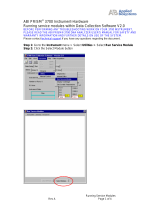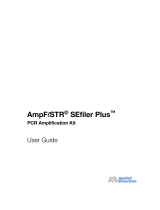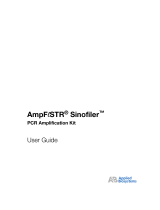Page is loading ...

User Bulletin
ABI PRISM 377 DNA Sequencer
June 5, 1997
SUBJECT: ModiÞcations for Subambient Temperature Operations
Purpose of this
User Bulletin
This user bulletin describes how to modify your ABI P
RISMª
377 DNA
Sequencer to accommodate an external gel cooling system for run
temperatures below the standard temperature. The standard run
temperature is ambient plus 10
°
C up to 60
°
C.
The following topics are included:
Topic See page
Purpose of an External Cooling System 2
Hardware and Software Requirements 2
How the External Cold Water Bath Functions 4
Installing the External Cold Water Bath 6
Operating at Subambient Temperatures 8
Avoiding Condensation 9

Page 2 of 10 User Bulletin : ABI PRISM 377 DNA Sequencer
Purpose of an External Cooling System
Performing SSCP
The ABI P
RISM
377 DNA Sequencer provides gel temperature control
from 10
°
C above the ambient temperature to a maximum of 60
°
C. To
perform PCR Single-stranded Conformation Polymorphism (SSCP)
protocols at lower temperatures (below 10
°
C above ambient), you
must attach a cold water bath to the instrument.
Refer to
PCR SSCP Analysis: A Guide to Fluorescent PCR
Single-stranded Conformation Polymorphism Analysis on the
ABI P
RISM
™
377 DNA Sequencer
(P/N 904413), for further
information.
Hardware and Software Requirements
Overview
To provide gel temperature control for operations at reduced
temperatures, you must have all of the following:
♦
an external cold water bath connected to the ABI P
RISM
377
♦
30 k-ohm thermistors installed on the instrument
♦
the ABI P
RISM
377 Data Collection 2.1 software
Hardware
Requirements
The water bath, polyurethane tubing, and tubing connectors needed
for the instrument modiÞcation must meet the following minimum
requirements.
Hardware Minimum Requirements
Water Bath Cooling capacity: 250 watts at 20
°
C
Heating capacity: 500 watts up to 60
°
C
Pump ßow rate: 1 gal/min or 4 L/min at pressure
head of 3 m
Automatic Shutdown: At high temperature and
low liquid-level
Polyurethane Tubing 6 ft. (1/4-in. i.d., 3/8-inch o.d.)
Tubing Connectors 1/4-in. female NPT, 1/4-in. male barbed Þttings
(NESLAB P/N 126000000007)

User Bulletin : ABI PRISM 377 DNA Sequencer Page 3 of 10
Any external water bath that meets these requirements should work
properly. The NESLAB Model RTE111 meets these requirements and
has been tested with the instrument.
Refer to the user manual for the water bath you select, follow proper
procedures, and ensure that all product safety and regulatory
requirements applicable to your location are met.
Changing Thermistors for SSCP
Most ABI P
RISM
377 instruments have 100 k ohm thermistors
installed. To perform SSCP at temperatures less than 22
°
C, you must
replace the 100 k ohm thermistors with 30 k ohm thermistors.
To determine which thermistors are installed on your instrument,
upgrade to the Data Collection 2.1 software, and check the Log Þle
from a recent run. The conÞguration information in the Log makes
reference to the type of thermistors installed.
Schedule a service call with your PE Applied Biosystems service
engineer for replacement of the 100 k ohm thermistors if you wish to
run SSCP at the lower temperatures.
Software
Requirements
The Data Collection 2.1 software upgrade contains all required
features to accommodate the external cold water bath, including new
chiller modules.
Refer to the user bulletin, ABI P
RISM
377
DNA Sequencer Data
Collection Software 2.1 Enhancements
(P/N 904945) for software
installation instructions, descriptions of features, and instructions for
using the new modules.
Requirements for
SpeciÞc Run
Conditions
Run Conditions Software
Thermistor
(ohms)
External
Bath
>10
°
C above ambient to 60
°
C 1.1 or 2.1 100 k not
required
SSCP from 22
°
C to ambient
+10
°
C
2.1 100 k required
SSCP at <22
°
C 2.1 30 k required

Page 4 of 10 User Bulletin : ABI PRISM 377 DNA Sequencer
How the External Cold Water Bath Functions
Disengages
Internal System
The ABI P
RISM
377 conÞguration with the external cold water bath
attached is similar to Figure 1 when viewed from the back. New
modules in the Data Collection 2.1 software disengage the
instrumentÕs internal pump system and switch to the external cold
water bath. When you turn the external valve so the arrow points
down, access to the internal gel temperature control unit is closed off.
Figure 1.
Rear view of the ABI P
RISM
377 with external water bath attached
Water Bypasses the Gel Temperature Control Unit
With the external cold water bath attached, water passes directly into
the front and back gel heat-transfer plates in the instrument,
bypassing the gel temperature control unit (Figure 2).
OUTLET
INTLET
GR0686
External valve,
arrow down

User Bulletin : ABI PRISM 377 DNA Sequencer Page 5 of 10
Figure 2.
ABI P
RISM
377 interior view with arrows showing water ßow.
Dotted line shows ABI P
RISM
377 components used with the external water
bath.
Standard
ConÞguration
Run Conditions
with External Bath
Attached
If the external water bath you use has heating capacity to 60
°
C, you
can run the instrument under standard conÞguration conditions
(ambient temperature plus 10
°
C to 60
°
C) with the external bath
attached.
Frequent monitoring of the water level is required when the external
bath is used during standard runs. For long periods of use,
disconnect the external water bath, reinstall the water bottle and
tubes, and use the standard run modules (not the chiller modules) in
the Data Collection 2.1 software Modules folder.
Refer to the
Data Collection Software 2.1 Enhancements
user bulletin
for the names of all the Data Collection 2.1 software modules and for
setting preferences to switch between the standard run modules and
the chiller modules.
GR0969
External
water
bath
External Valve, arrow down
Front plate
Back plate
Gel
temperature
control unit is
by-passed
Heat
exchange
Pump Heater
Flow sensor

Page 6 of 10 User Bulletin : ABI PRISM 377 DNA Sequencer
Installing the External Cold Water Bath
Positioning the
Machines
To position the ABI P
RISM
377 and external water bath:
Determining
Intake and Outlet
To identify the intake and outlet ßow tubes on the instrument:
continued on next page
Step Action
1
Place the ABI P
RISM
377 on a table or counter that provides easy
rear access.
2
Facing the ABI P
RISM
377, position the water bath on the right
side of the instrument and at the same height.
3
Plug both machines into an external power supply.
Step Action
1
Turn on the ABI P
RISM
377.
2
Open the right side panel where the water bottle for the internal
pump system is mounted.
3
Unscrew the water bottle, and slowly pull it down to expose the
ends of the tubes, but do not remove the bottle.
4
Observe the direction of water ßow from the tubes into and out of
the bottle to identify the intake and outlet tubes.
Note
Water coming into the bottle is from the instrument
outlet, and water being drawn out of the bottle is pumped into the
instrument intake. Some instruments have a small cutout at the
bottom of the water intake tube.
5
Turn off the ABI P
RISM
377.

User Bulletin : ABI PRISM 377 DNA Sequencer Page 7 of 10
Disconnecting the
Internal Pump
To disconnect the instrumentÕs internal pump:
Attaching the
External Cold
Water Bath
To attach the external cold water bath to the instrument:
Step Action
1
Remove the water bottle, and pull down the intake and outlet
tubes to remove them.
2
Store the tubes and water bottle for later use.
3
Step to the rear of the instrument, and turn the external valve so
that the arrow points down for the external position.
4
Cut two pieces of polyurethane tubing approximately three feet
(one meter) long to connect the external water bath to the intake
and outlet openings on the instrument.
5
Insert one end of a piece of tubing into the intake port on the
instrument.
6
Repeat step 5 with the second piece of tubing in the outlet port.
Step Action
1
Wrap the threads of the intake and outlet ports on the external
water bath with Teßon tape.
2
Attach a metal tubing connector to each port.
3
Connect the free end of the intake tube to the outlet Þtting on the
back of the external water bath.
4
Connect the free end of the outlet tube to the intake Þtting on the
back of the external water bath.

Page 8 of 10 User Bulletin : ABI PRISM 377 DNA Sequencer
Operating at Subambient Temperatures
Performing a Run at
Subambient
Temperatures
After your ABI P
RISM
377 is modiÞed for subambient temperature
runs, perform the following steps each time you use it:
To perform a run at subambient temperatures:
Step Action
1
Follow all instructions in the external water bath userÕs manual.
2
Fill the external water bath with cold, deionized distilled water,
and add antifreeze as recommended by the manufacturer.
! WARNING !
CHEMICAL HAZARD. Antifreeze may
cause respiratory tract, skin, and eye irritation. Wear
chemical-resistant gloves and safety glasses when
handling, and always use in a well-ventilated area.
3
Check that all tubing is tightly connected.
4
Turn on power to the external water bath, start the circulating
pump, and add water as needed to maintain the proper level.
IMPORTANT
If the water level drops below the level
recommended by the manufacturer, the circulation pump shuts
off, and the required temperature is not maintained.
5
Set the external cold water bath temperature about 3Ð4
°
C below
the desired gel plate temperature, and monitor the temperature in
the Status screen under the Window menu.
6
Place a lid on the bath to minimize evaporation.
7
Add water and antifreeze during operation as needed to maintain
the manufacturerÕs recommended water level.
8
Monitor the temperature and humidity in the lab (refer to the
following section, ÒAvoiding CondensationÓ).
9
Refer to the user bulletin,
ABI P
RISM
377 DNA Sequencer Data
Collection Software 2.1 Enhancements
(P/N 904945) for
software installation procedures.

User Bulletin : ABI PRISM 377 DNA Sequencer Page 9 of 10
Avoiding Condensation
Severe Damage
May Result
Operating the ABI P
RISM
377 DNA Sequencer at subambient
temperatures may cause condensation to form inside the instrument,
which can cause decreased performance and severe damage. To
avoid condensation, you must keep the water temperature above the
dew point (temperature at which water vapor condenses into liquid) or
lower the humidity in the room.
Consult the following tables to determine the dew point of water at
various relative humidities and ambient temperatures in your lab.
CAUTION
Condensation can cause decreased performance and
severe damage to the instrument. Monitor the room temperature and
humidity, consult the following condensation tables, and maintain the
water bath temperature setting above the corresponding dew point.
Dew Point Table
Ambient Temp.
15
°
C
Ambient Temp.
20
°C
Ambient Temp.
25°C
Ambient Temp.
30 °C
Ambient Temp.
35°C
Relative
Humidity
(%)
Approx.
Dew
Point
(°C)
Relative
Humidity
(%)
Approx.
Dew
Point
(°C)
Relative
Humidity
(%)
Approx.
Dew
Point
(°C)
Relative
Humidity
(%)
Approx.
Dew
Point
(°C)
Relative
Humidity
(%)
Approx.
Dew
Point
(°C)
100 15 100 20 100 25 100 30 100 35
90 14 90 18 90 23 90 29 90 33
80 12 80 16 80 21 80 26 80 31
70 10 70 14 70 19 70 24 70 29
60 12 60 17 60 21 60 26
50 10 50 14 50 19 50 23
40 10 40 15 40 19
30 10 30 15
20 9

© Copyright 1997, The Perkin-Elmer Corporation
Perkin-Elmer is a registered trademark of The Perkin-Elmer Corporation. ABI, ABI PRISM and the ABI PRISM design, Applied
Biosystems, PE, and PE Applied Biosystems are trademarks of The Perkin-Elmer Corporation. All other trademarks are the sole
property of their respective owners.
P/N 904056, Stock No. 237837-001
/












